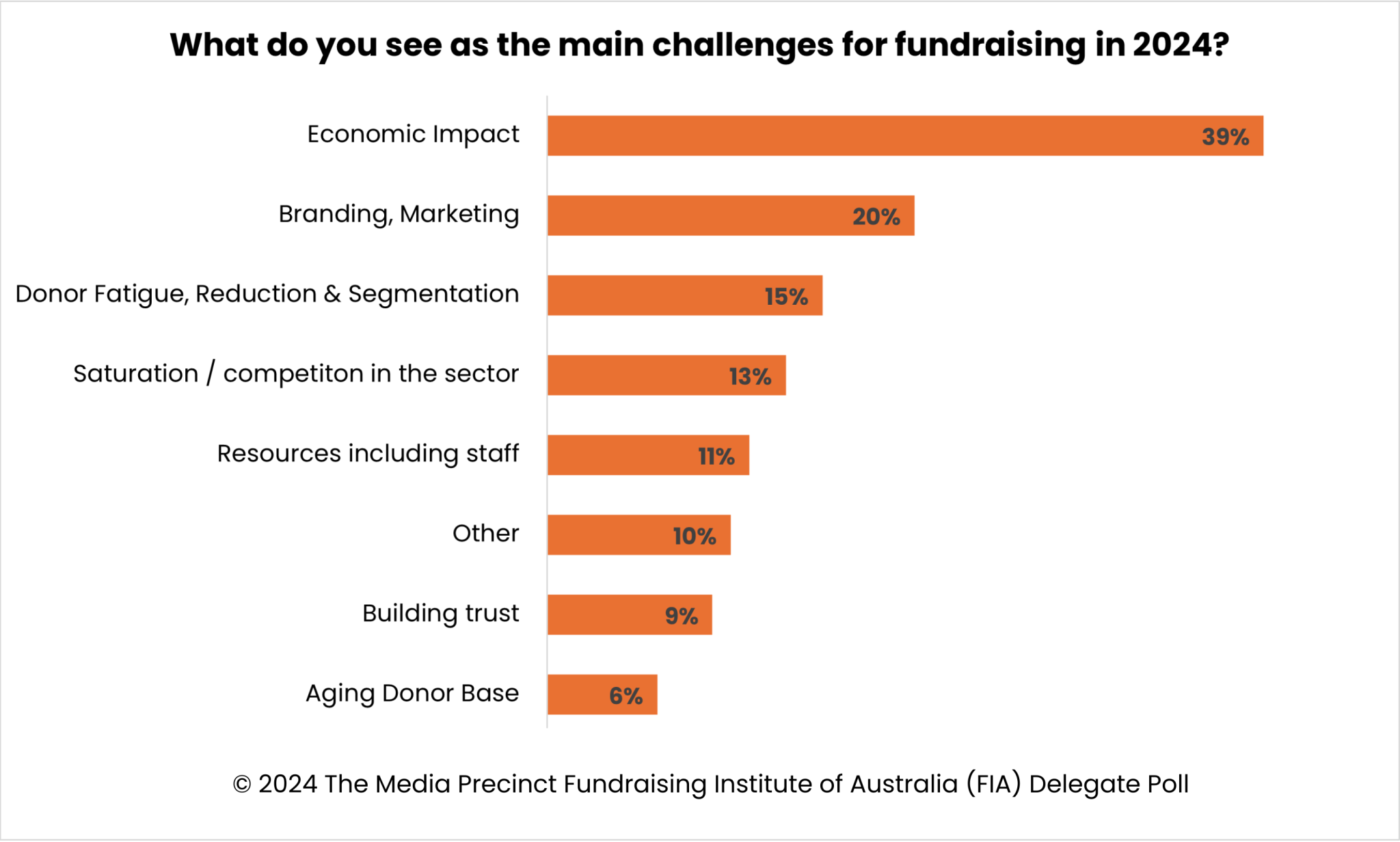Share

Given the economic headwinds that continue to buffet Australia, the role of the fundraising sector has never been so critical. The Media Precinct (TMP) recently participated in the Fundraising Institute of Australia (FIA) 2024 conference held in Brisbane. TMP shares their key takeaways from the event.
Economic challenges top poll
The conference presented an ideal opportunity for TMP to ask attendees what they felt were the main challenges for fundraising in 2024.
The data reports:
- Economic impact came out on top, cited as the biggest challenge by 39 percent of respondents
- Branding and marketing at 20 percent
- Donor fatigue, reduction and segmentation at 15 percent
- Competition in the sector at 13 percent
- Resourcing issues including staff at 11 percent
- Other factors at 10 percent
- Building trust at nine percent
- Ageing donor base at six percent

These responses tally with the results of the Fundraising and Donor Insight Survey conducted by TMP last year. The research revealed that Australia’s challenged economy is contributing to a shrinking of the nation’s charity donor pool at a time when there has never been a greater need for charity with so many causes and fundraising events vying for donors’ attention.
Challenging outlook
Since that survey, a combination of moderating inflation, the revised stage 3 tax cuts and anticipated interest rate cuts in quarter 4 has consumer sentiment on the recovery path, but still in highly pessimistic territory.
High inflation and the rapid and numerous raising of interest rates from 0.1 percent in May 2022 to 4.35 percent in November 2023, has depleted strong savings buffers built up during the pandemic, with the household saving ratio falling to its lowest level since 2007 at 1.9 percent.
The net result has seen real household disposable income per capita fall by 6.6 percent during 2023, resulting in household purchasing power declining to December 2015 levels.
TMP head of client services and growth Richard Turner says “there was overwhelming agreement among attendees that the cost of living and economic impact were their biggest challenges.”
“The trend among not-for-profits seemed to be that donors were not necessarily reducing the amount they’re giving but instead reducing the number of charities they’re giving to.”
“The sector’s reliance on older donors was also a concern,” he says. “People were saying ‘we can no longer rely on our regular donors – we need to find younger and new donors’, but they were unsure on how to do this.”
Another common stress is NFPs operating off reduced budgets resulting in cuts to staff and resources, while still needing to deliver similar or better outcomes.
However, at a time when out-of-the-box thinking and long-term strategic planning is needed most, “there seemed to be a struggle with forward-planning or thinking beyond campaign to campaign.”
“Alongside this, NFPs are not receiving support or buy-in from their boards or those of their corporate donors for long-term thinking or ideas that were different to the usual.”
Marcus Blease, co-founder and director of Donor Republic – Australia’s leading full-service marketing agency for the fundraising sector – says thankfully Australians are a very generous bunch.
“Giving creates a powerful emotion of positivity and hope, important in more challenging times, and as a consequence most charities and the causes they represent have not yet experienced a decline in giving.”
“Although donors most impacted by the economic conditions have reduced or stopped donating, this has been compensated by older donors who are less exposed to cost of living pressures, increasing their giving,” he says.
Know your audience and broaden your appeal
“The key for NFPs is understanding their audience, as well as their behaviours and motivations,” Turner says.
“It’s about defining who your target audience is and then it’s about understanding what you have to offer. How do you differentiate what you do?” Many charities have strong brand awareness in the community they serve, but need to expand their scope to broaden their donor pool beyond this,” he says. Blease concedes the drop off in new donor acquisition is cause for concern.
“It appears donors are focusing more on the causes they have traditionally supported and reducing the number of charities they give to.
“This is understandable, as cost of living continues to bite, particularly Gen X and Y – the largest supporters of event-based fundraising – raised less in 2023 from their friends, families members and colleagues, as the sector has seen a 16 percent decline in the average raised per participant.”
On a more optimistic note, Blease observes some recent marketing and engagement trends that his agency helped gain success for charities in the fundraising events space.
In the social media realm, Facebook and Instagram’s parent Meta is delivering stronger than ever returns for a lower cost per acquisition than at any time in the last eight years, “which is great,” he says.
“We’re finally seeing Tik Tok deliver some conversions to fundraising events at a higher scale, but at this point it’s only really working for certain youth-oriented cause types.”
Diving deep to connect
A tactic that is working well among successful fundraising teams is immersive ‘messenger journeys’, where participants of fund-raising events can delve into the real life stories of donor recipients or the work of care-givers enabled by the charity.
“We’ve been exploring ways to diversify engagement channels outside of email, SMS and phone and we’ve been piloting some complex messenger journeys to motivate and inspire event participants.”
“We’re also trying to embed a deeper connection to the cause within events, so where participants track their kilometres walked, we’re gamifying the journey by creating experiences that unlock information and content about the impact their participation and fundraising is having on the cause.”
Wills are the way
Among all the dark threats, Blease believes Gifts in Wills is a shining light of opportunity that the charity sector needs to invest much more in.
“As the boomer generation ages, the intergenerational transfer of wealth is going to be unparalleled and there is an opportunity for the charity sector to experience transformational growth by normalising and seeding the idea through all their supporter and beneficiary touchpoints.”
“At the moment the sector is not investing enough and it might miss out if it doesn’t act faster and think more long term,” says Blease.
The Media Precinct works with charities operating in an increasingly competitive market. Working with the not-for-profit sector extensively, our media, digital and creative teams understand the industry innately. We offer exclusive research that answers a lot of the questions marketers are asking, such as: ‘what influences someone to want to give in my sector’, or ‘how do I expand my donor pool?’
If you are a marketer struggling, get in touch with the Media Precinct team via email: [email protected] or phone: 02 8081 2660.















